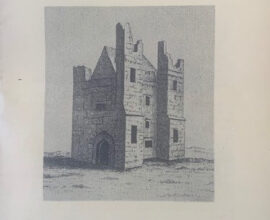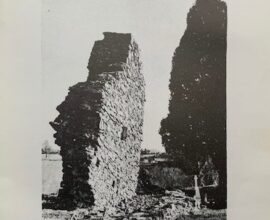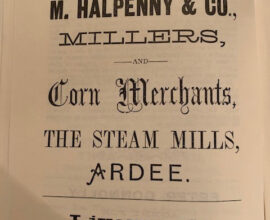Part 3: Alexander Dawson MP 1820 – 1831
by LD Murray, 1933
If we can rely on some of the newspaper accounts published at the period that Alexander Dawson was member for Louth, the latter’s great-grandfather, who lived at Kilcrow, Co Monaghan, divided his estates equally amongst his three sons, James, William and Jeremiah. James was succeeded by John, who, at an early age, was brought to Dublin under the auspices of his “cousin”. Alderman Richard Dawson “an eminent banker,” and commenced business in Castle Street, Dublin, about the year 1760. In 1763 he married Miss Pepper of Cookstown, County Louth, throught whom he acquired the Cookstown property.
At his time the extensive Armitgae estates in and around Ardee had been inherited in equal shares, by the families of Whaley and Taylor. By a marriage settlement, the Earl of Carrick became possessed of the Taylor share. The property was bought in 1792 by James Dawson of Cookstown: and in the division made the following year between the agents of Lord Carrick and R Whaley (the two representatives of the Armitage family), Riverstown and lands near Dunleer were assigned as Lord Carrick’s half, and passed into the possession of James Dawson.
A contemporary account says that Alexander Dawson, son of James, was born at Castle Street, Dublin in 1770; but local tradition insists that he was born at the Cookstoen residence. He was called to the bar in 1793, and for several years, followed that profession with considerable success. His brother James succeeded to the father’s business in Dublin and to the house in Castle Street. His sister, Catherine, was married to Captain Henry of Richardstown; and Margaret married Gerald Beahan.
Their father, John Dawson, was a most successful businessman and had amassed considerable wealth. In addition to being owner of two large estates in Co Louth he continued to carry on an extensive trade in Dublin as merchant, banker and broker. His will was made on 24 January 1801, and was registered on Feb 7 of the same year – so that he must have died in the interval;. He left £100 a yar to his wife; his Dublin property and the lands of Nicholastown Co Louthe to his son James; and small bequests to his two daughters who, probably had already received their dowries. To his son Alexander he left all his estate and interest in the lands of Cookstown, Rahanna and Ardee in Co Louth, Prospect in Co Monaghan and the tythes of Charlestown – subject to a charge of £800 for the interest of Miss Elizabeth Pepper. The will is printed in the section on Old Louth Wills.
Sarah Dawson, Alexander’s mother, was living at the time in Blackrock, Co Dublin and during the year after her husband died, she conveyed to Alexander the one-third interest in the lands of Cookstown and Rahanna which she had inherited under her father’s will of 1769. “ to establish him in a good-property.” In the following year (1804) he received a further accession of wealth through the death of his aunt, Elizabeth Pepper, to whom he was executor and residuary legatee – (see Elizabeth Pepper’s will under Old Louth Wills). At some time during the first decade of 1800s he decided to retire from the turmoil of forensic strife. He went to live at the paternal home at Riverstown and until he entered into the wider field of politics in 1826, occupied himself in the discharge of the duties of a leisured country gentleman. That he lived for a while at Priorland (near Dundalk) is shown by a lease granted in 1817 by “ Alexander Dawson of Priorland, Co Louth – to James Marron of Riverstown. Yarn dealer, and Patrick Lamb, tobacconist of Ardee “ – of ten acres of the lands of Riverstown together with a “right of passage to and from the Black Ridge and from the Scotch Meadow. “ In 1819, when he married Barbara Blayney, he was living at Riverstown. The marriage settlement, in which he granted her an annuity of £150, ws witnessed by Thomas Mathews of Drumcashel, and George Butler of Ardee, Carpenter. In 1823 his wife released him from the annuity charge.
The year 1826 stands out as a landmark in the history of Co Louth. The Catholic Association had already unfurled its banner in the South and Stuart of Dromara had been returned for Waterford against the whole power of the Beresfords. This success was natural and caused scarcely any surprise – but great excitement was caused throughout the whole country when it became known that a Liberal candidate would contest the representation of Co Louth against the powerul houses of Roden and Oriel. The Jocelyns and Fosters had established a sort of prescriptive right to the representation of the county, and it was considered the height of presumption and folly to hope for success against such a semmingly invulnerable coalition. Alexander Dawson was called from his tranquil obscurity to become the standard bearer of the people. The contest was anxiously followed by Irishmen all the world over. The candidates of the landlord party were Matthew Fortescue, the nominee of Lord Roden and Leslie Foster, representing the Oriel family. It was well known that the voters of Louth, if they should openly cast their votes against the landlords’ candidates, would risk eviction and ruin, with consequent starvation or emigration. The contest has been vividly described in most of the text books dealing with Irish history – probably best of all in Mitchell’s History of Ireland – and there is no need to repeat the story. On July 5 1826, the state of the polls was declared by the High Sheriff:

Alexander Dawson and Leslie Foster were duly elected to serve in Parliament for Co Louth. It would be difficult today to estimate or realise the moral effect of Dawson’s triumph. It was the first great victory in the fight for Catholic Emancipation. Its glory was somewhat eclipsed by the Clare election of 1828, but it was the Louth election that brought the question of Catholic emancipation into the sphere of practical politics. The so-called “ Ascendancy “ party had been routed in a constituency in which the long acquiescence of the electors had seemingly given them a kind of prescriptive right – and othe counties were not slow to follow the example. O’Connell’s election in 1828 brought matters to a crisis, and the Catholic Relief Bill passed into law in 1829.
Contemporary accounts support the popular tradition that Dawson possessed the highest qualifications for his post – considerable eloquence, sound judgment, unsullied integrity, obliging manners, and a devoted love for the people with whose cause he identified his political career. At the election of 1830 he was again returned at the head of the poll:

He died in the following year, 1831. I made an abstract of his will which was dated 1823, but the final portion of it has got torn away. The following is my note:
“Alexander Dawson – Will 1823. Left £150 a year to his wife and £350 a year to his brother James. Willed his property viz. Great Arthurstown, Little Cookstown, Rahanna, and Riverstown alias Town Parks of Ardee, tenements in Tisdall Street and Old Chapel Lane, and his land called Dawson’s Demesne in or near Ardee; and certain chief rents issuing out of lands or tenements in or near Ardee in possession of Nathaniel Manning, Thomas Lee Norman and the Reps of Dr Symes – all of which he was seized in fee except Dawsons Demesne which he held for a term of …. “
My transcript breaks off here, but my recollection is that the property was left to his brother James Dawson , in trust for John Henry Dawson (his son?) and Frances Leland.
After Dawson’s death, the property was dealt with in two separate lots. In 1832, John Henry Dawson of Richardstown sold all his rights in the Dawson’s Demesne property to William Leland of Drogheda, who, in turn, assigned them to Michael Brennan of Drumcashel for £1700. The last representative of this interest was Michael Brennan’s grand-daughter, Mrs Anne Quinn of Ardee.
The history of the remainder of the property – the portion held in fee – is very interesting. By an indenture dated 1833, James Dawson of Kingtown, only brother and heir-at-law of Alexander Dawson – sold to John Henry Dawson all the lands bequeathed in Alexander Dawson’s will (except Dawson’s Demesne already sold by John Henry Dawson, Alexander Dawson’s executer), “to carry out the provisions of Alexander Dawson’s will.” In 1839 Clargis Ruxton bought this property from Dawson and Leland for £6000 – but a short time afterwards there is record of a petition from “ Mahon, one of Dawson’s creditors, “ to have the sale re-opened, “ as William Shekleton was willing to give £500 more for it. “ Evidently the sale to Ruxton was allowed to stand, for, in 1840, there is record of an order from the Court that a conveyance be drawn up “ in the matter of the estate now bought by Clargis Ruxton from John Henry Dawson and Frances Leland. “
Richard Thomas Dawson
We may now return to the history of the senior branch of the Dawson family – the head landlords of the Ardee property. We have seen that Richard Dawson was murdered in his own avenue, on the night of March 10, 1783, when returning home from a visit to a friend. He was succeeded by Richard Dawson (MP for Monaghan) who was married to Catherine Graham of Hockley Armagh. It was he who granted the MacGauley lease which was the cause of so many auctions and lawsuits. His son, Richard Thomas Dawson, succeeded his grand-uncle as Baron of Dartrey in 1813 (see Genealogical Table0. We find an entry to the effect that, in the same year, he sold to Lord Carhampton of Sligo his 375 acres and Corn Mill in Ardee but we cannot reconcile that entry with the decision given in an important lawsuit in the year 1831. The plaintiffs were Francis Writght, William Broadhead, George Hicks, John Webb, Robert Huttin, John Hazel, Wright Baringer and John Erson and the defendants were Richard Lord Cremorne (Richard Thomas Dawson~, William Parkinson Ruxton, Catherine Dawson (Lord Cremorne’s mother), Joshua Spencer, William Furlong, Sir William Jackson, Thomas Poe, Edward Seymour and others. We have not been able to discover what exactly was at issue in this trial but the decision was:
“that the several sums in the Master’s report are decreed well charged on the lands and premises and it is decreed that the Master do in six months sell all that and those: the lands of Boolies, Ardee, Broadlough, Baltrasna, Mulladrillan, Newtown Baalregan, part of Castletown-Bellew, etc – subject to the jointure of £600 payable to the defendant Catherine Dawson. “
We have been informed that at the subsequent sale, the head rent of Dawson’s Demesne was acquired by O’Reilly Dease, who, at his death, willed it to the Commissioners of National Debt! O’Reilly Dease must have had a keen sense of humour. Considering the vicissitudes of the property since it had been forfeited by the Keppocks in the middle of the 17th century, as well as the frequency with which it had been used as a surety by successive needy owners and lessors, its acquisition by the Commissioners of National Debt was a fitting sequel to its chequered history.





Thank you for the wonderful history of the Dawson’s. Can you refer me to any similar work on the Keppoc family thanks patricia Smith
Can you please tell me the Christian name of McClintock, mentioned in the 1830 election as a candidate?
Would it be a McClintock of Drumcar?
My great uncle, Henry Foster McClintock, lived at Red House, Ardee until his death in 1958.
May I recommend the Journals of the Co Louth Historical Society to help with your enquiry.